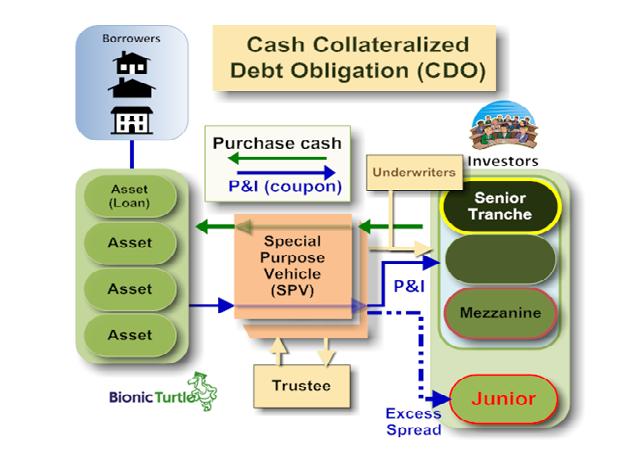Everything You Always Wanted to Know About CDOs (But Were Afraid to Ask)
~
A Transactional Genealogy of Scandal | From Michael Milken to Enron to Goldman Sachs
William W. Bratton
University of Pennsyvlania Law School; European Corporate Governance Institute (ECGI)
Adam J. Levitin
Georgetown University Law Center
August 13, 2012
Georgetown Law and Economics Research Paper 2126778
U of Penn, Inst for Law & Econ Research Paper No. 12-26
Abstract:
Three scandals have fundamentally reshaped business regulation over the past thirty years: the securities fraud prosecution of Michael Milken in 1988, the Enron implosion of 2001, and the Goldman Sachs “Abacus” enforcement action of 2010. The scandals have always been seen as unrelated. This Article highlights a previously unnoticed transactional affinity tying these scandals together—a deal structure known as the synthetic collateralized debt obligation (“CDO”) involving the use of a special purpose entity (“SPE”). The SPE is a new and widely used form of corporate alter ego designed to undertake transactions for its creator’s accounting and regulatory benefit.
The SPE remains mysterious and poorly understood, despite its use in framing transactions involving trillions of dollars and its prominence in foundational scandals. The traditional corporate alter ego was a subsidiary or affiliate with equity control. The SPE eschews equity control in favor of control through pre-set instructions emanating from transactional documents. In theory, these instructions are complete or very close thereto, making SPEs a real world manifestation of the “nexus of contracts” firm of economic and legal theory. In practice, however, formal designations of separateness do not always stand up under the strain of economic reality.
When coupled with financial disaster, the use of an SPE alter ego can turn even a minor compliance problem into scandal because of the mismatch between the traditional legal model of the firm and the SPE’s economic reality. The standard legal model looks to equity ownership to determine the boundaries of the firm: equity is inside the firm, while contract is outside. Regulatory regimes make inter-firm connections by tracking equity ownership. SPEs escape regulation by funneling inter-firm connections through contracts, rather than equity ownership.
The integration of SPEs into regulatory systems requires a ground-up rethinking of traditional legal models of the firm. A theory is emerging, not from corporate law or financial economics but from accounting principles. Accounting has responded to these scandals by abandoning the equity touchstone in favor of an analysis in which contractual allocations of risk, reward, and control operate as functional equivalents of equity ownership, and approach that redraws the boundaries of the firm. Transaction engineers need to come to terms with this new functional model as it could herald unexpected liability, as Goldman Sachs learned with its Abacus CDO.
Copy of the paper below…
~
4closureFraud.org
~
A Transactional Genealogy of Scandal | From Michael Milken to Enron to Goldman Sachs


No Comment